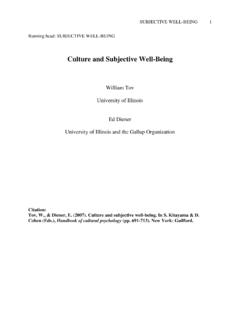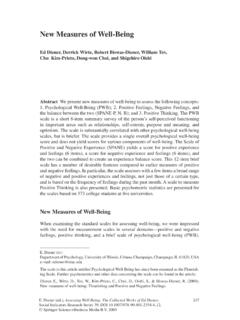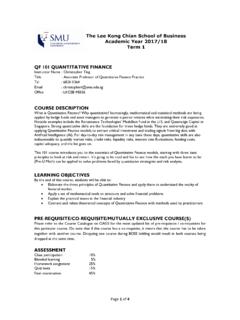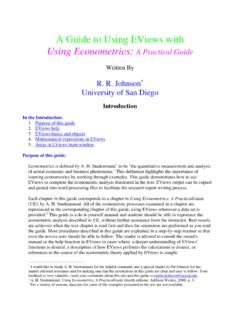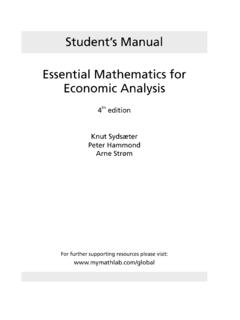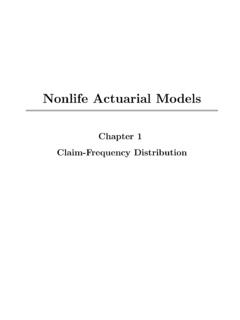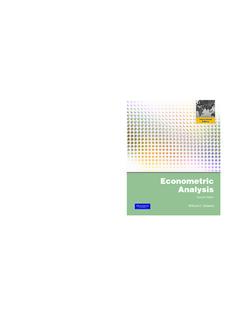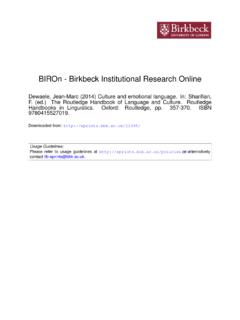Transcription of CULTURAL SIMILARITIES AND DIFFERENCES IN THE ...
1 CULTURAL SIMILARITIES AND DIFFERENCES IN THECONCEPTUALIZATION OF EMOTIONC hristie Napa Scollon and William TovSingapore Management UniversityCitation:Scollon, C. N., & Tov, W. (2012). CULTURAL SIMILARITIES and DIFFERENCES in theconceptualization of emotion. In P. A. Wilson (Ed.), d Studies in Language: Vol. 27. Dynamicity in emotion concepts(pp. 235-252). Frankfurt, Germany:Peter :Research on emotional experiences across cultures is reviewed from acultural psychological perspective. Psychometric approaches to evaluating thestructure of emotions has consistently replicated two broad dimensions(positive and negative affect) in several countries. Nevertheless, there arecultural DIFFERENCES in other aspects of emotional experience such as therelation between positive and negative affect, the nature of specific emotions( , pride and affection), and the types of emotions that are valued.
2 Recentresearch on the cognitive organization of emotional experiences may provideadditional insights and these methods await broader application in cross- CULTURAL : culture , emotion, affect, measurement1. IntroductionIn this paper we examine three important facets of culturalconceptualizations of emotion. First, we review the vast literature on cross- CULTURAL equivalence in the structure of , issues ofequivalence have been addressed through psychometric approaches, makingthis section the also address concerns about language,translation, and whether indigenous emotions add to the study of culture , we discuss other important considerations beyondpsychometric structure such as CULTURAL DIFFERENCES in the desire for particularemotion states. Lastly, we consider new and cutting edge research on thecognitive associative networks of emotion as a means of understandingcultural conceptualizations of emotions exist on many levels the physiological, appraisal, expression , behavioural often researchers are interested in the subjectiveexperience of emotions as well.
3 In other words, how people feel. The mostcommon way to assess subjective feelings is directly by asking people toreport on their own subjective states. While there are debates about theveracity of self-report measures of emotion ( , Can people really know howthey are feeling?), by and large, how people believe they feel is meaningfulirrespective of the accuracy of such reports. To put it simply, if a personsayshe feels happy or sad or angry, that is worth emotion can be measured either as a state or a measures ask people to rate the extent to which they arecurrentlyexperiencing various emotions. These measures emphasize the momentary,fleeting experience of emotion and can fluctuate over the course of a day. Incontrast, trait measures ask people to rate the extent to which theygenerallyexperience various emotions.
4 These measures emphasize stability inemotional experience. Although emotions fluctuate, some individuals tend toexperience positive (or negative) emotions more than others. Thus, traitmeasures capture individual DIFFERENCES in the overalltendencyto experiencecertain emotions. Both measures provide distinct types of information. Aperson who is generally happy (trait measure), may or may not be happy atany given moment (state measure). Moreover, many self-reported emotionsfallin betweenstate measures of momentary feelings and trait measures ofgeneral feelings. As people are asked to report their feelings over broader andbroader periods of time (from the current moment to the past day, week,month or year), emotion measures become more trait-like. That is, peoplerely more on their beliefs about how theytypicallyfeel rather than literallyrecalling every momentary emotional experience they have had (Robinson &Clore, 2002).
5 In our discussion, we will consider both types of self-reportedemotion related idea concerns how cultures construct and define overalljudgments of life satisfaction or happiness. Although global life satisfactionand emotions are related, they are conceptually and empirically separable(Lucas, Diener, & Suh 1996). Life satisfaction involves a cognitive judgmentof one s life as a whole, which may or may not be informed by a person semotional experiences. The present paper focuses only on emotion ratingsand not on global evaluations of life satisfaction. Readers who are interestedin CULTURAL constructions of life satisfaction are referred to Kwan, Bond, andSingelis (1997) and Suh, Diener, Oishi, and Triandis (1998).2. How do we know if people in different cultures mean the samething when they answer questions about their emotions?
6 : Thepsychometric approachGiven that researchers commonly ask people to report on their ownsubjective states, how can we compare two respondents, Miki and Katy, onthe question of How muchjoyhave you experienced in the past week? Suppose Miki is a Japanese college student, and Katy is an American collegestudent. How can we be sure that Miki s and Katy s interpretations of thewordjoyare the same? Such concerns are at the forefront of culture andemotion research regardless of whether measures are translated into nativelanguages. In other words, simply translating the wordjoytoureshiidoesnot ensure that the meaning of the emotion concept is the same. Before wecan say that Miki reports greater or less joy than Katy, we first need to knowif they conceptualize joy in the same typical way of verifying conceptual equivalence is by establishingthat the structure of emotion is the same for different CULTURAL groups.
7 Thiscan be achieved through statistical methods such as factor analysis, structuralequation modelling, and cluster analysis. Although the various psychometrictechniques differ in many details beyond the scope of this chapter, the basicpurpose is the same. Responses to several emotion items are used to createa covariance matrix of all items. Structural analyses reveal patterns in thecovariance matrix such as which emotions occur together (are positivelycorrelated), which are opposites (negatively correlated), and which areindependent of one another (uncorrelated). In other words, analysis of thecovariance matrix reveals which emotions are conceptually similar ordissimilar. Ifprideandjoyare conceptually similar, they ought to be morestrongly correlated than, say, two groups conceptualize emotion terms in the same way, then theyought to share similar covariance structures of emotion.
8 Structural similaritycan take a few forms. First, the CULTURAL groups may share the same higherorder dimensions or factors such as the emergence of two dimensions inwhich all the pleasant emotions group together and all the unpleasantemotions group together. Second, the relationbetweenthese higher orderdimensions may or may not be similar across CULTURAL groups. For example,the pleasant and unpleasant dimensions may be positively correlated in somesamples, but negatively correlated or uncorrelated in others (Bagozzi, Wong, Scollon, Diener, Oishi, & Biswas-Diener, 2005; Perunovic, Heller, &Rafaeli, 2007).Third, although the overall nature of the higher orderdimensions may be similar across cultures,specificemotions may group withor load on to different factors in different samples. For example, even if thestructure of emotions in two samples is represented by two factors, positiveand negative, for one sample the emotionpridemight group with emotionssuch asjoy,happiness,excitement, whereas for another sample, the emotionpridemight group with emotions such assadness,guilt, andanger.
9 Weaddress each of these structural possibilities in greater detail in the covariance structure analyses such as those described above,another method for examining conceptual equivalence is item responsetheory (IRT). IRT methods can determine whether people from differentcultural groups use emotion scales in the same way (see Oishi, 2007). Forexample, both Miki and Katy may experience similar levels of positiveemotions overall, however Miki might be less likely than Katy to reportexperiencing pride. This would suggest that pride is somewhat less diagnosticof positive emotional experience in Miki s culture than Katy is important to note that studies that rely on structural analyses ofself-reports or IRT methods target the experience or phenomenologicalaspects of contrast, other methods directly examine thecognitive representations of emotion words.
10 For example, researchers mayask participants to rate how similar various emotion words are to one another(Russell, Lewicka, & Niit, 1989) or categorize emotion words on the basis oftheir prototypicality (Shaver, Wu, & Schwartz, 1992). Although the presentpaper focuses largely on self-reports of emotions, the various types of studieshave yielded converging evidence on the structure of equivalence of emotion terms might also be evaluated byexamining how people from different cultures recognize or categorize facialexpressions of various emotions. For example, people may be shown apicture of a smiling woman and asked to select which emotion she is feeling:angry,sad, surprised, guilty,orhappy( , Ekman, Sorenson, & Friesen,1969).Cross- CULTURAL studies of emotional expression have shown thataround the world, people tend to interpret facial expressions similarly, thoughnot exactly the same way.
